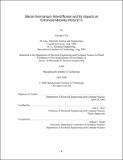| dc.contributor.advisor | Judy L. Hoyt. | en_US |
| dc.contributor.author | Xia, Guangrui, 1976- | en_US |
| dc.contributor.other | Massachusetts Institute of Technology. Dept. of Electrical Engineering and Computer Science. | en_US |
| dc.date.accessioned | 2007-07-17T19:39:57Z | |
| dc.date.available | 2007-07-17T19:39:57Z | |
| dc.date.copyright | 2006 | en_US |
| dc.date.issued | 2006 | en_US |
| dc.identifier.uri | http://hdl.handle.net/1721.1/37840 | |
| dc.description | Thesis (Ph. D.)--Massachusetts Institute of Technology, Dept. of Electrical Engineering and Computer Science, 2006. | en_US |
| dc.description | This electronic version was submitted by the student author. The certified thesis is available in the Institute Archives and Special Collections. | en_US |
| dc.description | Includes bibliographical references (p. 180-188). | en_US |
| dc.description.abstract | As complementary metal-oxide-semiconductor field-effect transistors (MOSFETs) scale, strained Si and SiGe technology have received more attention as a means of enhancing performance via improved carrier mobility. One of the biggest challenges for strained Si and SiGe technology is Si-Ge interdiffusion during thermal processing. Two different aspects of Si-Ge interdiffusion are explored in this work. The first part of this work demonstrates that Si-Ge interdiffusion and ion implantation damage during the fabrication of strained Si MOSFETs have significant impact on electron mobility and thus device performance. Long channel n-MOSFETs with different thermal processing and implant conditions were fabricated on both CZ Si wafers and strained Si/relaxed Sio.8Geo.2 heterostructures. In order to avoid scattering by ionized dopant impurities, neutral Si and Ge were implanted into the channel at six different doses ranging from 4 x 1012 cm-2 to 1 x 1015 atoms/cm2. It is shown that the mobility enhancement factor is degraded by RTA and ion implantation. For each RTA condition, there is a threshold implantation dose, above which the strained Si mobility starts to degrade significantly. The degradation is larger for devices with higher thermal budgets or implantation doses. | en_US |
| dc.description.abstract | (cont.) Si-Ge interdiffusion at the strained Si/relaxed Sio.sGeo.2 interface was found to be the major mobility degradation mechanism for devices with higher thermal budget, while for devices with lower thermal budget, residual ion implantation damage in the strained Si channel is considered to be the key degradation mechanism. Two-dimensional simulations are performed to generate as-implanted damage profiles of 30-nm scale MOSFETs. By comparing the 2D damage profiles with those generated by Si blanket implants, it is shown that 30-nm p-MOSFETs are more likely to suffer from mobility degradation than n-MOSFETs. The second part of this work, which is the main focus of this thesis, systematically investigated the Si-Ge interdiffusivity in epitaxial strained Si/SilyGey/strained Si/relaxed Silx.Gex and strained Si/relaxed SijlxGe, heterostructures for Ge fractions between 0 and 0.56 over the temperature range of 770 - 920 °C. Based on the interdiffusivity extracted from experiments, an analytic model was established for interdiffusion simulation. To the best of our knowledge, this work is the most complete study of Si-Ge interdiffusion and modeling to date. Boltzmann-Matano analysis was applied to extract interdiffusivity from the diffused Ge profiles of strained Si/relaxed SiljxoGexo heterostructures. | en_US |
| dc.description.abstract | (cont.) A model for the interdiffusivity suitable for use in the process simulator TSUPREM-4 was formulated. Si-Ge interdiffusivity was found to increase by 2.2X for every 10% increase in Ge fraction for interdiffusion under relaxed strain. Significantly enhanced Si-Ge interdiffusion was observed in SijlyGey layers under biaxial compressive strain. Si-Ge interdiffusivity was found to increase by 4.4X for every 0.42% increase in the magnitude of compressive strain, which is equivalent to 10% decrease in the substrate Ge fraction xo. These results were incorporated into an interdiffusion model that successfully predicts the interdiffusion of various SiGe heterostructures. Examples of the impact of interdiffusion on device design and process integration issues were given. | en_US |
| dc.description.statementofresponsibility | by Guangrui Xia. | en_US |
| dc.format.extent | 188 p. | en_US |
| dc.language.iso | eng | en_US |
| dc.publisher | Massachusetts Institute of Technology | en_US |
| dc.rights | M.I.T. theses are protected by copyright. They may be viewed from this source for any purpose, but reproduction or distribution in any format is prohibited without written permission. See provided URL for inquiries about permission. | en_US |
| dc.rights.uri | http://dspace.mit.edu/handle/1721.1/7582 | |
| dc.subject | Electrical Engineering and Computer Science. | en_US |
| dc.title | Silicon-Germanium interdiffusion and its impacts on enhanced mobility MOSFETs | en_US |
| dc.title.alternative | Si-Ge interdiffusion and its impacts on enhanced mobility metal oxide semiconductor field-effect transistors | en_US |
| dc.type | Thesis | en_US |
| dc.description.degree | Ph.D. | en_US |
| dc.contributor.department | Massachusetts Institute of Technology. Department of Electrical Engineering and Computer Science | |
| dc.identifier.oclc | 132719622 | en_US |
